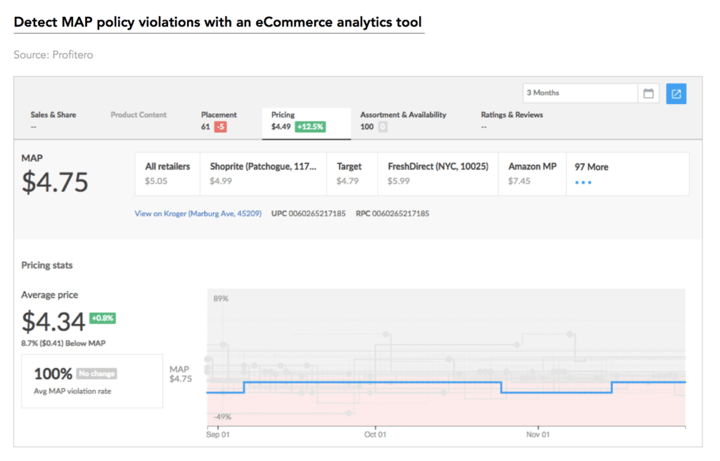

At Profitero, we’ve written a lot about the online retailer price wars and how it’s driving massive price erosion for brands selling online. The good news is: there is a way to fight back.
Enter the MAP policy.
A Minimum Advertised Price (MAP) policy is a tool brands have at their disposal to help deal with deflationary price pressures. In practice, many companies don’t have a MAP program in place—only about 20% of brands, according to Garrett Bluhm, Vice President of Ecommerce and Marketplace Strategy at Pattern (formerly iServe), a leading authorized marketplace seller that specializes in MAP compliance and unauthorized seller identification.
But for companies that do, MAP is a hot topic.
MAP policies are written to let authorized resellers know the lowest prices at which a brand manufacturer will allow those resellers to advertise its products.
Daren S. Garcia, partner and online seller enforcement attorney with law firm Vorys, told Profitero of a few critical distinctions to keep in mind:
- MAP relates only to the advertised price, not the actual resale price itself; and
- MAP is not an agreement, but a unilateral policy. What this means is that a company that establishes a MAP policy is stating that it will only do business with those entities (i.e., resellers) that follow its policy.
“Most manufacturers adopt a ‘3 strikes and you’re out’ enforcement strategy for violating resellers,” notes Garcia. First, they issue a violation warning. Then they usually stop shipment for some period of time, e.g., 30 or 60 days, on the SKU in question. Finally, they terminate the business relationship.
A MAP policy is not the right solution for everyone
MAP is best suited for companies with significant brand equity and value associated with the product’s image in the market. Traditionally, it lends itself more to non-commoditized, differentiated products that are integral to a brand manufacturer’s success.
In contrast, MAP is more difficult to enforce with low dollar, highly commoditized product. You often don’t see MAP policies in place for many high-velocity, high household penetration categories, e.g., many widely distributed grocery and consumables items.
“MAP is ultimately just a tool that works well if you have control over your products and your brand. And by control, we mean that your distribution is appropriately controlled, you know who your customers are, and you know who’s reselling your products,” Garcia said. “A problem you run into with MAP is that you want to put a policy in place, and your good retailer customers want to abide by it—they’re happy you put it in place because it protects brand equity and incentivizes continued investment in your brand.
“But brands often have very little control over products downstream—with a lot of unauthorized resellers on online marketplaces, for example, not following their MAP policy. So, now your good customers are pointing at those unauthorized sellers—because they can be very disruptive. Unless you have the ability to target and remove those unauthorized sellers, your MAP policy is not going to work because your good customers will get frustrated and refuse to follow it themselves,” says Garcia.
The hard truth is MAP violations are more prevalent than you’d think. According to a Northwestern Kellogg School study, 53% of unauthorized retailers violate MAP policies compared with 15% of authorized retailers.
Key questions: How do you detect MAP violations? How do you stop them?
The best way is by having a system in place that enables you to routinely monitor performance metrics. Pay particular attention to such things as a drop in Average Selling Price (ASP), losing the Buy Box to third-party (3P) sellers more frequently, and possibly EFP (Exclusively for Prime) or CRaP (Can’t Realize a Profit) designations—red flags that can indicate something’s amiss with your pricing, including possible MAP violations.
3P sellers can indeed win the Buy Box more often if they’re violating MAP. The challenge comes in identifying 3P sellers in question and tracing the chain of custody to determine if their source of supply is somebody you have an authorized distribution agreement with. Ultimately, you may need to cut off that supply.

5 principles for drafting and enforcing effective MAP policies
- Align executives around the strategic importance of maintaining brand equity, ASPs and margins—there are short-term trade-offs with major long-term benefits
- Write a clear, precisely worded and unambiguous policy with the help of your brand protection experts and/or legal counsel
- Be strategic about how you document noncompliance—package your evidence for a senior audience (but have the underlying detail if necessary)
- Hold retailers and resellers accountable swiftly and consistently—i.e., apply policy unilaterally across all customers
- Follow the “3 strikes and you’re out” tenet: (1) Issue a violation warning; (2) Stop shipment for a reasonable time period; (3) Terminate the business relationship
To learn more about protecting your price integrity, download our eBook: Avoiding a Race to the Bottom: How to create a sustainable eCommerce pricing strategy.


























